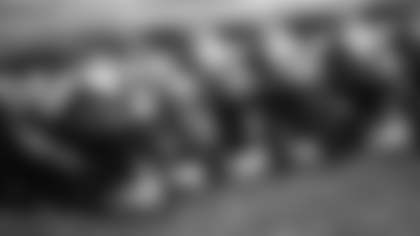Senior Bowl Week is ending, but that doesn't mean we're done looking at all we learned over the past three days.
The Washington Commanders will have more projected available cap space than any team in the league and nine draft picks to work with this offseason, and while there are some "cornerstone" players on the roster, as general manager Adam Peters put it, there is still a long list of needs the franchise needs to address. Luckily, there were plenty of prospects in Mobile, Alabama, that could help bolster the team as they usher in a new era.
So, let's look at five takeaways from the three Senior Bowl practices that were available for media members to attend.
1. This year's class of offensive linemen is talented.
The Commanders need at least some help on the offensive line after allowing the second most sacks in the NFL. They could take one of the top tackles with the No. 2 overall pick, but the potential of taking a franchise quarterback off the board is probably too tempting to pass up. They could use one of their four other picks in the top 100 to take an offensive lineman, though, and there should be plenty to choose from.
There were several guards and tackles from both the American and National teams that held their own against a stacked group of defensive linemen (more on them later). Whether they want a starter or a long-term project, the Commanders will have options on how to improve the position. If they want experience, Houston's Patrick Paul -- Chris Paul’s younger brother -- is a player who has the physical traits at 6-foot-7 and 315 pounds. Patrick Paul did have moments where his stance was a little high, and his punch was slow when he went against players like Chris Braswell, but he does have some tools that the right coach could develop into starting caliber material.
The biggest riser at tackle might have been Texas' Christian Jones. He was not high on many analysts' big boards prior to this week, despite starting 48 games for the Longhorns, but that should change after winning most of his reps in 1-on-1 pass protection drills. Jones was patient, kept his head back when engaged and did a good job of mirroring defenders. He even won reps against standouts like Braswell and Missouri's Darius Robinson.
Oklahoma's Tyler Guyton is another tackle who's steadily rising up boards. His technique is raw in some areas, but there's no denying the results. He's athletic, explosive and has an excellent first step. Guyton also improved each day, particularly with his punch. His palms faced upward in pass protection drills, which often led to him "catching" defenders rather than punching them. In Days 2 and 3, his palms faced outward, and his arms didn't drop. That led to better reps, most of which were wins for him.
2. The receiver class lived up to its reputation.
This year's receiver class has received no shortage of praise for the past few weeks. Players like Marvin Harrison Jr. and Malik Nabers are the obvious leaders, but the word has been that teams could find meaningful contributors in Days 2 and 3 of the draft.
It looks like that is absolutely the case.
It's hard to name one player that stood out among the rest, because most of them had strong weeks. USC's Brenden Rice probably wasn't the fastest receiver of the bunch, but he was certainly one of the strongest, showing off his hands and ability to make catches through contact. He also is not afraid to leap over defenders to make grabs, a trait that teams like Washington don't have outside of **Terry McLaurin.**
In terms of route running, there were few players better than Florida's Ricky Pearsall. Like Rice, Pearsall is not known for his speed, but he does know how to get open by finding soft spots in zone coverage. He has some quickness in his routes and can make catches in traffic. Regardless of whether the Commanders choose to select a quarterback, those traits could make him a reliable target for young signal-callers.
At slot, Michigan's Roman Wilson was one of the smallest receivers at the Senior Bowl, but he always managed to get open and make yards after the catch. He was also called out by Toledo's Quniyon Mitchell and made a one-handed sideline grab at the end of practice on Day 2.
There are several other receivers who left a strong impression on scouts this week, but the point is that if Washington does want to add more talent at receiver this offseason, they will have no trouble doing so.
3. The running backs were dynamic.
Today's running backs must be able to do a little of everything, and this year's crop of players did exactly that in Mobile this week.
Kentucky's Ray Davis is a wrecking ball, weighing 215 pounds at just 5-foot-10. He's a solid runner, showing vision, burst, patience and a lack of fear when it comes to contact. His ability as a pass-catcher stood out more often during practice, and it wasn't just as an option in the screen game. He was lined up more as a receiver and looked natural doing it. He also caught a touchdown pass on Day 3 during red zone drills.
There likely weren't many football fans or scouts who had heard of New Hampshire's Dylan Laube prior to this week, but the Long Island, New York, native is probably going to get more attention after a strong week of practice. Laube is also 5-foot-10, but he knows how to get into the second levels of defenses and lay hits on defensive backs when he gets there (he delivered a lick to a cornerback on Day 1 during team drills after a run down the left sideline).
Laube is also one of the more interesting pass-catchers for the position. He ended his five-year college career with 1,743 yards and 13 touchdowns, and he can be explosive with receptions of 87, 86 and 80 yards.
Those are just two names, but there's also Arizona's Michael Wiley, TCU's Emani Bailey and Marshall's Rasheen Ali. The Commanders could need to add more depth to the running back position this offseason, and like receiver, there will be plenty of Day 2 and Day 3 prospects that offer exciting skill sets.
4. There were a lot of quality pass-rushers, both in the interior and on the edge.
There's been a lot of talk about offensive players, but let's wrap things up by looking at the other side of the ball.
Each defensive lineman had their moments during one-on-one pass protection drills, but there were a few standouts among the bunch. Let's start on the edge with Alabama's Braswell. The Crimson Tide defensive end looked consistent throughout the week, as he showed a mix of power and speed. His ability to quickly get his hands into the chests of offensive linemen led to easy wins for him, as he was able to either bull rush them into the quarterback or swipe their hands away and breeze by them. There was also Missouri's Robinson, who displayed a knack for attacking tackles' inside shoulders.
Speaking of bull rushes, Texas' T'Vondre Sweat was the best when it came to having his way with centers and guards. He does have some burst and decent hand speed, but he was most effective when he used his size advantage to simply push players backwards. There were few players who could counter that, and even those that did still gave up ground.
One of the more surprising players was Florida State's Braden Fiske. At just shy of 300 pounds, Fiske is on the small side, but that didn't stop him from making life hard on interior players. Despite being smaller than his competition, he managed to win many of his reps because of his motor, which elevated his physicality and athleticism.
The Commanders do need help on the defensive line, both in terms of finding starters and depth. Looking to improve the defense with the No. 2 overall pick is unlikely, but dipping into that talent pool with one of their four Day 2 picks is certainly a possibility.















